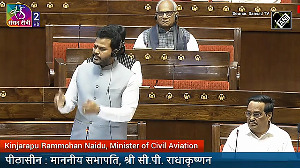Many perceptions about Muslims are sought to be broken by the Sachar Committee, which says their population growth has slowed down and that less than four percent of children from the community take madrasa education.
It says there is a 'substantial demand' from the community for fertility regulation and for modern contraceptives.
'Muslim population growth has slowed down as fertility has declined substantially, clearly showing that Muslims are well into demographic transition. In the future, growth is bound to be slower and eventually population is bound to reach replacement level', the report says.
It notes that religion is an important element that influences the lifestyle of sizeable segments of citizens, but its impact on regulating human fertility of Muslims is 'not strong'.
Over 20 million Muslim couples currently use modern contraceptives and this number will grow if quality and choice-based reproductive healthcare services are made available to the community, the report by the seven-member committee headed by former Delhi High Court Chief Justice Rajindar Sachar says.
'However, the relatively higher incidence of poverty and the widening gap in literacy between the Muslims and other comparable socio-religious categories, particularly among women at young ages, could in fact impede the decline in Muslim fertility', it adds.
'The growth rate for Muslims, as for the total population, is bound to fall further and eventually reach a zero growth stage. There are strong indications that this could occur well before the end of the century', the report says.
It also refers to what it calls uneven distribution of Muslim population, which it notes has a high concentration in some states that are lagging behind in development.
'Bringing down regional disparities could go a long way in reducing demographic disparities', it says.
By the end of the 21st century, India's Muslim population is projected to reach 320-340 million in a total of 1.7 to 1.8 billion people and the share is likely to be 18-19 percent.
The 2001 census has put India's Muslim population at 138 million-plus.
In its report, the Sachar committee insists that madrasas have also provided mainstream education in many cases - '... and several of them are in the process of modernising their curriculum'.
Also, the committee reports that there is a tiny population of school-age Muslim children who attend madrasas.
'It is important to take note of the fact that less than four per cent of the Muslim children in the school-going age actually attend full-time regular madrasas', it says.
In its findings, the Sachar committee has also pointed to SC/ST reservations in posts for Urdu teachers.
'Often Urdu schools have teachers who have no knowledge of Urdu. This problem is partly compounded by the fact that posts of Urdu teachers are reserved for SCs and STs and such candidates are not available. This anomaly needs to be corrected', it says.





